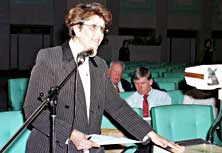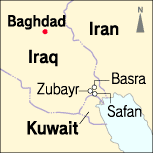Discounted Casualties:The Human Cost of Depleted Uranium, Part 5 <2>Environmental contamination – Still serious in the south
Jun. 19, 2000
Appeal by survey scientists
"Radioactive contamination is still serious in southern Iraq, where vast amounts of depleted uranium (DU) munitions were used." Souad Naji Al-Azzawi (47), assistant professor at the University of Baghdad points to the data as she explains to a group of about 50, mostly Americans. She speaks in fluent English about the environmental contamination derived from DU munitions.
Unable to measure immediately after the fighting
"For example, soil we sampled in five places, including Safan and Zubayr, contains 850 to 65,200 Becquerel per kilogram of thorium 234 (Th234). The natural radiation figure for thorium is zero. This Th234 was produced by the decay of DU (U238). Becquerel is a unit that measures the number of atoms that decay per second."
She explains in simple terms that anyone can understand. "About 125,000 people live in the surveyed areas. Of course, there is a direct effect on current residents, but we are also gravely concerned about future contamination of crops, livestock and underground water."
This lecture by Souad at a hotel in Baghdad lasted a little over thirty minutes. To learn more about the results of the surveys, the next morning I visited the College of Engineering on the University of Baghdad campus in the outskirts of town. Souad is director of the doctorate program in environmental engineering. Her office is on the second floor.
"This is the material from which I took the lecture you heard yesterday." It is written in English and Arabic, so she explained it to me.
"Our team of six researchers began the survey in 1996. Every year since we've been tracking the expansion of the contaminated area caused by the movement of sand. However, it is really a tragedy that we were unable to go in and survey radiation levels immediately after the DU munitions were used."
Estimates based on a formula
It was 1993 when Souad first learned that US and British troops had used DU munitions. At the time, there were problems getting the right measuring equipment and she had to keep up with her regular job, so she was unable to go out and survey the area.
It took three years to get to it. Using a formula applied to her measurements, she has calculated the radiation in the air, water, and soil immediately after the fighting. Then, factoring in wind strength and direction, the movement of sand and other factors, she has estimated the effect on Basra, the largest city in southern Iraq with a population of about 1.6 million.
"The greatest impact on human health is definitely from inhaling the DU particles formed when the munitions were used. The residents of Basra must have been exposed at the time. Iraqi soldiers were also exposed, but depending on specific circumstances, the Iraqi soldiers moving toward the north were probably less at risk than the American and other soldiers of the multinational force who were downwind."
Souad's words rang with the conviction of an experienced environmental engineer backed by research.
"I want people to know the danger"
"I always wanted to be a scientist, even when I was little." She took her children to Colorado when she was thirty to study at the Colorado School of Mines. She studied geological and environmental engineering. She received her Ph.D. for research on underground water contamination in Colorado due to nuclear power generation. Immediately after graduating in January 1991, she ended nine years of life in the United States and returned home in the midst of the Gulf War.
When I told her that during my interviews at the US and UK Defense Departments, the ones who used the DU munitions claimed that there was "no substantial impact on the environment." She looked amazed and countered.
"That might be true if it were just a few rounds. But we are talking about thousands, ten thousands, maybe a million rounds. That's quite different. The half-life of U-238 is 4.5 billion years. DU is also highly toxic chemically. People and animals are living right there. How can they deny any impact without even doing any research?"
What Souad needs most is a mass spectrometer that can accurately measure alpha radiation, She also needs a laptop computer she can take with her to survey sites. "I want to collect more accurate scientific data. This is not so much to argue with the Pentagon. The important thing is to let people around the world know the hazards of DU."
Her evident passion revealed as well the profound frustration of a born scientist unable to properly pursue her interest.
(Originally published on June 19, 2000)









